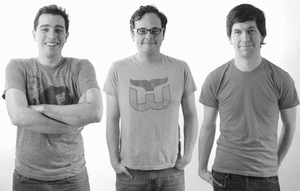Who knew that alumni were funny?
by Taylor Coe '13
ARTS & ENTERTAINMENT EDITOR
The premise of a Hamilton Alumni Comedy show seemed a little strange at first. Of all the professions I envisioned when coupled with the words “Hamilton alumni,” neither stand-up comedian nor sketch-comedy troupe was among them. Despite my assumptions, Katey Healy-Wurzburg ’05, Justin Tyler ’01, Selena Coppock ’02, Chris Sessa ’06 and Liza Rothschild ’08 stormed the Events Barn last Saturday night for an hour and a half of stand-up and sketch comedy.
 Misguided though my alumni expectations were, four of the five alumni still hold day jobs in addition to their work in comedy—Coppock is a book editor for Barnes and Noble, Sessa and Rothschild are in ad-sales and Healy-Wurzburg works in administration for a biotech company. Seen in light of their day jobs, the idea of comedian alums no longer seems so outlandish or impossible. The only member without a day job (though he bartends once a week) is Tyler, who works with his sketch comedy group Sidecar—from which he also brought non-alumni Alden Ford and Emily Axford.
Misguided though my alumni expectations were, four of the five alumni still hold day jobs in addition to their work in comedy—Coppock is a book editor for Barnes and Noble, Sessa and Rothschild are in ad-sales and Healy-Wurzburg works in administration for a biotech company. Seen in light of their day jobs, the idea of comedian alums no longer seems so outlandish or impossible. The only member without a day job (though he bartends once a week) is Tyler, who works with his sketch comedy group Sidecar—from which he also brought non-alumni Alden Ford and Emily Axford.
“I have a nine-to-five, but ideally I want to not do that,” said Coppock. “I want to work in the [comedy] industry and be paid to do what I love.” Tyler, as far as the other alums are concerned, seems to be living the dream. Tyler’s recent success is due both to his work at the UCB Theatre in New York City as well as his voiceover work. Recently, Tyler became the new voice of Comcast, as heard in the 30-second television spots with Jane Lynch.
As the informal host of the comedy show, Tyler demonstrated why he is able to live off his comedy and voiceover work. He has quite a voice—not like the soporific baritone of movie trailers—but a friendly voice, maybe the voice of a reasonable friend. Then there is the brand of humor, which is—in a complimentary sense—kind of dorky. Deus ex machina jokes? Birds-and-the-bees conversations?
Tyler’s work, of course, is rooted in improv and sketch comedy, not in the traditional stand-up routine that other alumni offered. Healy-Wurzburg, another occasional UCB performer, probably had the best stand-up set, including a discursive bit about menstruation, setting the gross-out bar high for the night; her contribution was matched only by Sessa’s insistence on telling a joke about mandatory prison rape with the goal of lowering the crime rate. But Sessa’s joke floundered in comparison with Healy-Wurzburg’s matter-of-fact dirty language. Sessa tried to play along with the audience, whereas Healy-Wurzburg simply told it like it was—I never got the impression that she cared if she was funny or not.
Throughout the night, the performers attempted to weave Hamilton-specific humor into their material; the references mostly seemed pointed to a general collegiate audience until Coppock assumed the stage. A segment about Campus Security led into a narrative about an ill-timed streaking odyssey across the main quad. Coppock’s story would have been good anywhere, but Hamilton geography and institutional understandings certainly helped.
Stand-up and sketch comedians often get a bad rap. Sometimes they come off as offensive; sometimes they come off as crazy or neurotic. But the alumni comedians dispelled these apparent shortcomings.
“I think stand-up is an analytical exercise—so I think you are self-aware and analytical somewhat—which can be misconstrued as neurotic potentially,” said Coppock. “I think it’s just sort of about being thoughtful about things.”
So while we may not receive any concrete knowledge listening to Katey Healy-Wurzburg’s stand-up set, we can certainly tap into a mind not our own. I certainly had not pictured a New York subway as a “rape submarine,” but I don’t doubt that the image will not leave me anytime soon.
